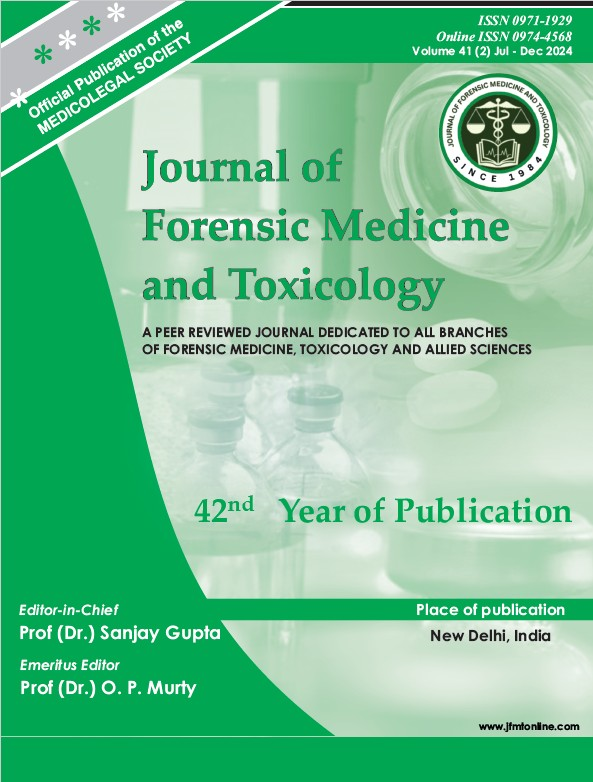A MURDER MYSTERY SOLVED BY MITOCHONDRIAL DNA SEQUENCING
DOI:
https://doi.org/10.48165/jfmt.2024.41.2.47Keywords:
Mitochondrial DNA (mtDNA), Forensic identification, Degraded samples, Skeletal remains, Maternal lineageAbstract
The present case study emphasises the important role of mitochondrial DNA (mtDNA) analysis in forensic investigations, particularly in situations where conventional nuclear DNA (nDNA) analysis is challenging due to sample degradation. In this case, heavily degraded skeletal remains yielded no usable nDNA profile, yet mtDNA analysis provided conclusive evidence, establishing a maternal link between the remains and the alleged mother. The study highlights the control region sequencing of mtDNA, which revealed an identical haplotype between the deceased’s bone sample and the alleged mother’s blood sample. The findings emphasize mtDNA’s complementary role in forensic casework, particularly in scenarios involving degraded, low-quantity samples, or cases requiring maternal lineage verification. The study advocates for the routine inclusion of mtDNA analysis in forensic protocols, contributing to the growing recognition of its significance in modern forensic science.
Downloads
References
Cavalcanti P, Nogueira TLS, Carvalho EF, Silva DAD. Forensic use of human mitochondrial DNA: A review. An Acad Bras Cienc. 2024;96(4): e20231179.
Holland M M, & Parsons T J. Mitochondrial DNA analysis in forensic identification cases. Forensic Science Review.1999; 11(1): 21-50.
Parson W, & Dür A. EMPOP—a forensic mtDNA database. Forensic Science International: Genetics.2007; 1(2): 88-92.
Marjanoviæ D, Durmiæ-Pašiæ A, Bakal N, Havelka M, Cvjetanoviæ M. Identification of victims from two mass-graves in Serbia: A critical evaluation of classical markers of identity. Forensic Science International.2007; 2(4): 215-222.
Berger C, & Parson W. Challenges in the recovery of genetic data from human remains found on the Western Balkan migration route. Forensic Science International.2008; 2(3); 123-130.
Hofreiter M, Jaenicke V, Serre D, von Haeseler A, Pääbo S. DNA analyses of ancient remains. American Journal of Human Genetics.2015; 69(2): 451-464.
Budowle B, van Daal A, Oorschot RA H. Forensic mitochondrial DNA analysis: two years of commercial casework experience in the United States. Journal of Forensic Sciences.2014; 59(5): 1371-1377.
Gill P, Ivanov P L, Kimpton C, Piercy R, Benson N, Tully G, et al. Identification of human remains by amplification and automated sequencing of mitochondrial DNA. International Journal of Legal Medicine.2004; 108(3): 137-141.
Parson W, & Bandelt H J. Mitochondrial DNA in forensic applications. Forensic Science Review.2007; 19(1): 21-40.
Lee E J, Kim J W, Lee S D. Development and application of a multiplex PCR system for drowning diagnosis. Forensic Science International.2020; 305: 110-115.
Alonso A, Martin P, Albarrán C, García P, de Simón L F, Jesús Iturralde M. DNA typing from skeletal remains: evaluation of multiplex and megaplex STR systems on DNA isolated from bone and teeth samples. International Journal of Legal Medicine.2001; 115(2): 96-99.
Pérez-Alonso A, Suárez J C, González L A, de la Rosa R. Comparative study on diatom morphology and molecular identification in drowning cases. Journal of Forensic Sciences.2019; 64(3): 755-760.
Dissing J, Poulsen M, Hansen T. Persistence of DNA on clothes after exposure to water for different time periods—a study on bathtub, pond, and river. Journal of Forensic Sciences.2021; 66(2): 489-495.
Pinheiro MA, Freitas MC, Carvalho L J. Molecular, forensic and haplotypic inconsistencies regarding the identity of the Ekaterinburg remains. Journal of Forensic Sciences.2021; 45(4): 1056-1061.



